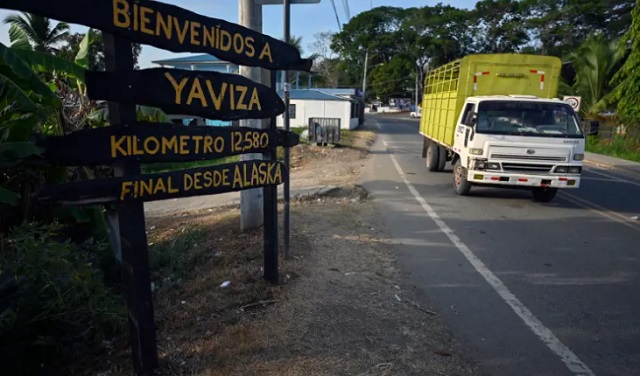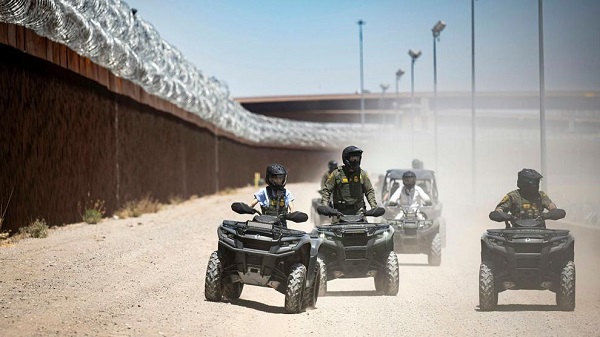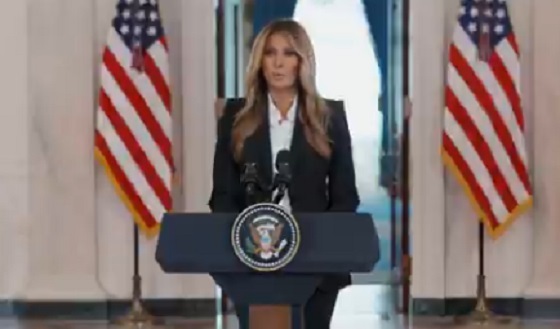illegal immigration
Biden/Harris made empty promises to stop migrants in Panama — but the flood continues

A sign at the end of the notorious Darien Gap in Panama — where 1.5 million migrants have traveled since 2021.Photo by LUIS ACOSTA/AFP via Getty Images
From the New York Post
By Todd Bensman
On July 1, Panama’s new President José Raúl Mulino took office on an unprecedented promise to close a major route of illegal immigration — through which at least 1.5 million foreign nationals have poured through since 2021.
Mulino said he would close the infamous Darién Gap, a 70-mile roadless jungle wilderness that South American migrants traverse on their way north to the United States.
He secured a promise from the Biden-Harris administration to help accomplish this: money and possibly even planes to carry illegally arriving migrants back to their countries.
A map of the 70-mile route that migrants take on the Darien Gap while passing through Panama.
But nearly two months after the US pledged a “removal flights program” to support Panama, the aid is nowhere to be found and the immigrants, after sheltering in place at home or in Colombia to see if Panama might actually deport people, are starting to flow once again through the Darién Gap.
‘We need support’
“We’re waiting,” said a senior Panama government official, who spoke on condition of anonymity because of the diplomatic sensitivity of the topic. “We are [ready] to do our part of the agreement but we need the resources. We don’t have the airplanes to move the big numbers we need to.”
The official said the lack of American follow-through is probably “political” but has become more urgent to counter a new wave of Venezuelans — long among the most numerous nationalities crossing through Panama — who are now fleeing a fresh round of political violence.
Panama wants to dramatically increase air expulsions of Venezuelans back to Colombia to “change their mindset” so that fewer will want to make the dangerous trek.
But the Panamanian official said his country can’t afford to go it alone much longer.
Migrants boarding a boat in Colombia to head to the Darien Gap.CIS.ORG
A group of migrants sailing from Colombia to Panama.CIS.ORG
Migrants arriving in Panama.CIS.ORG
“We understand that we need logistical support to reinforce the expulsion of migrants . . . so we can avoid the movement and the normal flow to the United States,” the official said. “We need to change the migration politics of the border of the United States so we can send a very clear message to the migrants.”
His comments follow a similar public nudge from Panama’s presidential palace.
“The ball is in their court; we have done everything we can do,” President Mulino said at an Aug. 9 press conference in Panama City, referring to the Biden-Harris White House. “The border is in Panama, not in Texas.”
Catch-&-release logic
The American delay in following through, given the latest Venezuela unrest — and also the paltry $6 million the White House reportedly offered Panama for air expulsions — is inexplicable, given that Panama’s newfound willingness to reduce US-bound immigration on its territory represents a golden opportunity for the administration.
Polling shows the border crisis figures large as a political liability for Harris.
But it is in keeping with a Biden-Harris administration that has worked overtime to increase illegal-border crossing.
Rather than discourage passage through the Darién Gap, the US worked with the previous Panamanian government to make it easier to get through.
Migrants walking along a jungle path while traveling from Colombia to Panama on May 9, 2024.AP Photo/Ivan Valencia
Migrants riding a small boat on a river in Panama’s Darien province on Oct. 6, 2023.AP Photo/Arnulfo Franco, File
In 2022, for instance, Homeland Security Secretary Alejandro Mayorkas and Secretary of State Anthony Blinken pressured the Panamanian government to open a shorter sea and river route, built larger and new hospitality rest camps, and arranged for dozens of United Nations and nonprofit migrant advocacy groups to provide all manner of aid and assistance.
These moves induced hundreds of thousands more border crossers per year to make the trip.
As a direct result of Biden-Harris catch-and-release policies, the Darién Gap passage became a major factor in the worst mass migration crisis in US history, funneling millions of illegal immigrants north.
A woman carrying a child as she crosses the Acandi River in Colombia on Sept. 15, 2024.AP Photo/Fernando Vergara
A migrant camp at the Reception Center for Migrant Care in Lajas Blanca, Panama on June 27, 2024.Photo by MARTIN BERNETTI/AFP via Getty Images
Election pressure
Fewer than 20,000 economic immigrants per year ever passed through the Colombia-Panama passage before the Biden-Harris administration, yet 250,000 passed through it in 2022, 520,000 last year and a projected 800,000 by the end of 2024.
With the election looming, Biden did pressure Mexico to try to reduce the all-time-record border crossings of 10,000-to-14,000-a-day.
Panama’s then-president-elect Jose Raul Mulino visiting the Reception Center for Migrant Care on June 28, 2024.Photo by MARTIN BERNETTI/AFP via Getty Images
The outreach has helped ebb the tide slightly and avoided some of the more shocking pictures and videos from overwhelmed border checkpoints.
So why the delay with Panama?
Perhaps it’s because the border has been “solved” just enough for optics sake ahead of the election. But Kamala Harris has absolutely no intention of following through with tougher border policies if elected.
If Harris wins in November, she won’t have to unravel a commitment to actual deportations in Panama that neither she nor her progressive liberal base authentically support or want, and the Darién Gap superhighway that they support can remain wide open.
Todd Bensman, a senior national security fellow at the Center for Immigration Studies, is the author of “Overrun: How Joe Biden Unleashed the Greatest Border Crisis in U.S. History.” Follow his progress through the Dairen Gap and Panama at CIS.org.
Business
Truckers see pay surge as ICE sweeps illegal drivers off U.S. highways

Quick Hit:
American truckers say they’re finally earning more per mile as President Donald Trump’s enforcement push clears illegal drivers off U.S. highways. Truckers have reported 50% pay increases on some routes following a surge of ICE activity and Transportation Secretary Sean Duffy’s crackdown on safety and work permit violations.
Key Details:
- A trucker on X said his usual Chicago-to-Fargo run jumped from $1,200 to $1,800, crediting the Trump administration’s immigration enforcement for thinning out illegal competitors.
- ICE and federal transportation officials have detained or removed illegal drivers in multiple states, with reports of Serbian and Indian drivers losing their commercial licenses after failing to prove legal entry into the U.S.
- FreightWaves founder Craig Fuller noted spot rates have risen about 2% despite weak demand, as “bottom feeders” who undercut prices are being “squeezed out of the market.”
Diving Deeper:
As President Trump’s immigration enforcement intensifies, American truckers are seeing something rare in a sluggish cargo economy: rising wages. Across online freight boards and social media, truckers are crediting the administration’s “Compliance Crunch” — a combination of ICE raids and new safety regulations — for clearing out illegal drivers who had been depressing pay rates for years.
One trucker wrote on X that his typical Chicago-to-Fargo route, which paid $1,200 before the election, now brings in $1,800. “Needless to say, I took him up on the offer,” he posted. “Lord do I hope this hangs around a little bit.”
Transportation Secretary Sean Duffy has been enforcing long-ignored safety and documentation rules, targeting companies that hired drivers without valid immigration status or complete customs paperwork. “We have Americans who’ve been in trucking for 50 years through family businesses,” Duffy told Fox News on October 8. “They can’t do business anymore because you have these illegals coming in, living out of their trucks… they can’t speak the language, and they come in under price — way under price.”
According to reports from The Serbian Times, at least fifteen Serbian drivers have been detained in recent days, and agents have begun seizing commercial driver’s licenses from migrants lacking proof of legal entry. Many of these drivers, primarily from Eastern Europe and South Asia, were able to operate under the Biden administration with minimal oversight — often undercutting legitimate American drivers by accepting lower pay.
Craig Fuller of FreightWaves observed that even though freight volumes remain “anemic,” per-mile spot rates rose roughly 2% as noncompliant firms exit the market. “We are seeing the bottom feeders get squeezed out,” he wrote, adding that most contract carriers haven’t yet felt the wage impact but likely will as enforcement spreads.
Industry experts say nearly one-third of the nation’s freight has been hauled by non-citizen drivers, which trucking analyst Bill Skinner called “not just a safety issue — it’s a national security risk.”
While some corporate logistics networks such as Amazon and Walmart may eventually argue that higher trucking wages could drive up costs, analysts note that the increases are modest and likely offset by fewer accidents, delays, and fraud cases tied to unlicensed or illegal operators.
illegal immigration
$4.5B awarded in new contracts to build Smart Wall along southwest border

Homeland Security Secretary Kristi Noem rides an ATV along the U.S.-Mexico border wall in El Paso, Texas, on April 28, 2025. Photo: Tia Dufour / U.S. Department of Homeland Security
From The Center Square
By
New contracts to add 230 miles of barriers, nearly 400 miles of technology
Roughly $4.5 billion in contracts have been awarded to expand border wall construction, including adding advanced technological surveillance along the southwest border.
Ten new construction contracts have been awarded through the U.S. Department of Homeland Security and U.S. Customs and Border Protection to add hundreds of miles of Smart Wall in California, Arizona, New Mexico and Texas.
“For years, Washington talked about border security but failed to deliver. This President changed that,” CBP Commissioner Rodney Scott said. “The Smart Wall means more miles of barriers, more technology, and more capability for our agents on the ground. This is how you take control of the border.”

Scott has championed advancing a Smart Wall border security system for years. A border security system is far more than a wall, he has told The Center Square, it’s an ecosystem.
The system encompasses steel and waterborne barriers, patrol roads, lights, cameras, advanced detection technology, including towers and aerostats, to provide Border Patrol agents with a range of tools to detect and interdict illegal activity.
CBP has published an interactive map to educate the public about the Smart Wall system. The map highlights areas of the 1,954-mile U.S.-Mexico border where wall construction has been completed, where border wall panels or waterborne barriers are under construction, where contracts have been awarded for proposed projects in the design phase or early construction, and planned construction areas that haven’t yet been awarded contracts.
Prior to Jan. 20, 2025, 702 miles of existing barriers had been constructed of primary wall and 76 miles of secondary wall, according to CBP data.
The new plan includes implementing barrier technology along 532 miles of the border where no barrier exists because of unfavorable terrain or remote location. It also includes deploying 550 miles of technology throughout previously constructed barriers, CBP says. Specific areas are also being built out in regions where contracts were previously canceled by the Biden administration.
In California, $483.5 million in taxpayer funding was awarded to BCCG Joint Venture for the Diego 1 Project to construct nine miles of new Smart Wall and 52 miles of system attributes in the San Diego Sector.
An additional $574 million was awarded to Fisher Sand & Gravel Co. for the El Centro 1 Project to construct eight miles of Smart Wall and install 63 miles of system attributes in the San Diego and El Centro sectors.
In California and Arizona, $199.5 million was awarded to Barnard Spencer Joint Venture for the Yuma 1 Project to construct 60 miles of system attributes in the Yuma Sector.
In Arizona, nearly $607 million was awarded to BCCG for the Tucson 1 Project to construct 23 miles of new secondary border wall and 66 miles of system attributes in the Tucson and Yuma sectors.
In New Mexico, $155.1 million was awarded to BCCG for the El Paso 1 Project to replace seven miles of old dilapidated barrier fencing in the Santa Teresa Area of Responsibility with a new Smart Wall. BCCG will also complete 22 miles of system attributes in the El Paso Sector in New Mexico.
Also in the El Paso Sector in New Mexico, Barnard Spencer Joint Venture was awarded nearly $579 million for the El Paso 2 Project to construct 23 miles of new Smart Wall and 81 miles of system attributes.
In the El Paso Sector in far west Texas, BCCG Joint Venture was awarded $850.4 million for the El Paso 3 Project to construct 42 miles of new primary Smart Wall, six miles of new secondary border wall and 46 miles of system attributes.
In Texas, BCCG Joint Venture was awarded $565 million for the Del Rio 1 Project to construct 22 miles of new primary Smart Wall, replace two miles of old barrier wall, and deploy 40 miles of waterborne barrier system in the Eagle Pass Area of Responsibility in the Del Rio Sector.
BCCG was also awarded $364.3 million for the Del Rio 2 Project to construct 10 miles of new primary Smart Wall, 23 miles of waterborne barrier system, and install 10 miles of system attributes in Eagle Pass.
BCCG was also awarded $96.1 million for the Rio Grande Valley Waterborne Barrier Project to deploy 17 miles of waterborne barrier in the Rio Grande River, south of Brownsville in Cameron County in the Rio Grande Valley Sector.
Another $550 million worth of contracts was also awarded to support Smart Wall construction. Additional construction and contracts are expected.
Funding for the projects comes from the “One Big Beautiful Bill,” which President Donald Trump signed into law. It also includes some fiscal year 2021 border wall appropriations that were frozen during the Biden administration.
Waivers were also issued by DHS Secretary Kristi Noem to expedite construction of nine miles in the San Diego Sector and 30 miles in the El Paso Sector in New Mexico. Both sectors were inundated with record high illegal traffic during the Biden administration.
-

 Alberta12 hours ago
Alberta12 hours agoFact, fiction, and the pipeline that’s paying Canada’s rent
-

 2025 Federal Election20 hours ago
2025 Federal Election20 hours agoProtestor Behind ‘Longest Ballot’ Chaos targeting Poilievre pontificates to Commons Committee
-

 illegal immigration2 days ago
illegal immigration2 days ago$4.5B awarded in new contracts to build Smart Wall along southwest border
-

 International2 days ago
International2 days agoMelania Trump quietly reunites children divided by Ukraine war
-

 COVID-192 days ago
COVID-192 days agoThe Trials of Liberty: What the Truckers Taught Canada About Power and Protest
-

 Brownstone Institute1 day ago
Brownstone Institute1 day agoTrump Covets the Nobel Peace Prize
-

 International1 day ago
International1 day agoHamas releases all living hostages under Trump peace plan
-

 Business1 day ago
Business1 day agoUN, Gates Foundation push for digital ID across 50 nations by 2028
















